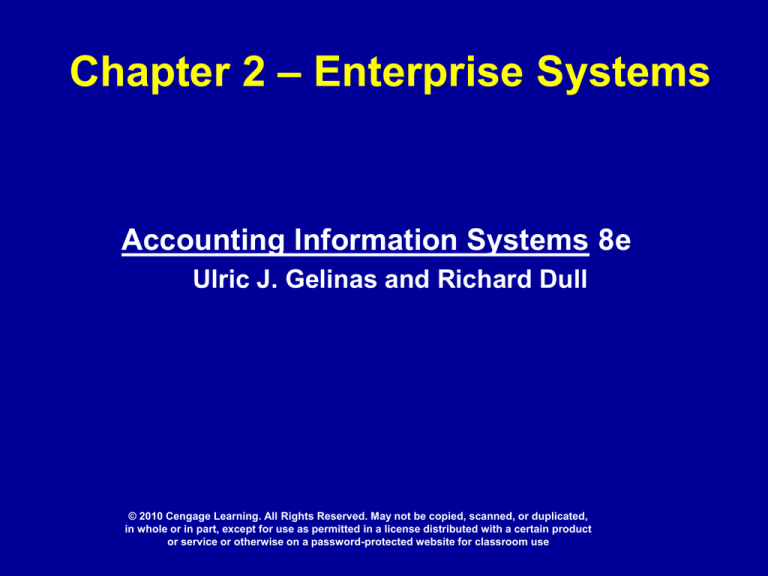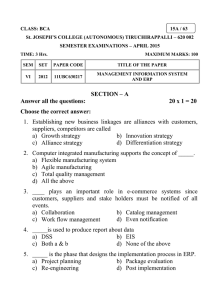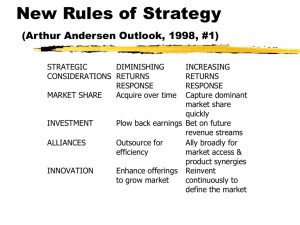
Chapter 2 – Enterprise Systems
Accounting Information Systems 8e
Ulric J. Gelinas and Richard Dull
© 2010 Cengage Learning. All Rights Reserved. May not be copied, scanned, or duplicated,
in whole or in part, except for use as permitted in a license distributed with a certain product
or service or otherwise on a password-protected website for classroom use
Learning Objectives
• Describe enterprise systems.
• Describe enterprise resources planning (ERP)
systems.
• Explain the organization value chain.
• Describe the relationship of the organization value
chain and an enterprise system.
• Illustrate the value of systems integration.
• Describe how an enterprise system supports major
business event processes.
• Enumerate the pros and cons of implementing
enterprise systems.
2
Enterprise Systems
• Integrates business processes and
information from entire enterprise.
• Helps coordinate the operation of
business functions.
• ERP systems are software packages
that can be used for the core systems
necessary to support enterprise
systems.
3
Integrate Business
Functionality
When purchasing equipment the ERP will:
• Provide an electronic order form.
• Apply business rules.
• Route the order for approvals.
• Send the order to a buyer.
• Connect to the vendor.
• Use data to receive goods, project funding
requirements, compare to budget, and
analyze vendor performance.
4
ERP Systems Vendors
5
mySAP
Business
Suite
6
Third-Party Modules
• Customer Relationship Management
(CRM) - builds and maintains customer
related data.
• Customer Self-Service (CSS) - allows
customers to complete tasks without
assistance.
• Sales Force Automation (SFA) - automates
sales tasks such as order processing and
tracking.
7
Third-Party Modules, Cont’d.
• Supply Chain Management (SCM) - plans and
executes demand planning, inventory acquisition,
manufacturing, distributing and selling.
• Product Lifecycle Management (PLM) manages product data from design through
disposal of product.
• Supplier Relationship Management (SRM) manages the interactions with organizations that
supply the goods and services to an enterprise;
includes procurement and contract management.
8
SAP
NetWeaver
9
Enterprise Systems Value
Chain
• Enterprise systems facilitate value chain
management.
• The value chain is the system of
activities that transform inputs into
outputs valued by the customer.
• The goal of an organization is to add the
greatest value at the lowest cost thus
increasing competitive advantage.
10
Value
Chain and
Value
System
11
The Value of Systems
Integration
• Coordination of activities in the value
chain.
• Performs this coordination by sharing data
across business processes.
• The following slides describe what life
would be like without integrated systems
and how enterprise systems solve some of
the problems.
12
Inefficient Customer Service
1. Check
to see if
the
customer
is in good
standing
– i.e. has
good
credit.
13
Inefficient Customer Service
2. Find out if
the item in
stock and
ready for
delivery. Tell
the customer
when she will
receive
the item. This
date is known
as “available
to promise” or
ATP.
14
Inefficient Customer Service
3. If item is not on
the shelf, review
production
schedule and add
the time required
to pick, pack, and
ship. This does
not, however, tell if
the item had
already been
allocated to
another customer.
15
Inefficient Customer Service
4. If the item must
be scheduled for
manufacturing,
when can it be
scheduled and
how long will the
process take? It
depends on the
availability of the
production line
and personnel, as
well as the
required raw
materials.
16
Inefficient Customer Service
5. May
require
contacting
the vendors
that supply
these
materials to
determine
when they
can promise
delivery.
17
Inefficient Customer Service
6. What price
will be charged
to this customer
for this order?
This price may
be found on a
static price list.
However, the
marketing
department may
determine
prices
dynamically.
18
Inefficient Customer Service
7.Need to know
if the amount of
the order falls
within the
customer’s
credit limit.
Without direct
access to the
open AR data,
need to call
accounting to
approve this
order.
19
Inefficient Customer Service
8. If policy is
not to turn
down an order
for insufficient
credit without
checking with
the credit
department the
credit
department
must be called.
20
Inefficient Customer Service
• Do you think that Sally wants to keep
the customer on the phone throughout
this process?
• Would you consider this to be good
customer service?
21
Solution to Inefficient
Customer Service
• Enterprise system establishes ATP
(available to promise) by checking
warehouses and scheduled
manufacturing.
• Database automatically determines
price and creditworthiness.
22
Data Maintenance: Create
Customer Record
23
Business Event Data Processing:
Enter Customer Order
24
Using Stored Data for
Decision Making
25
Major ERP Modules
Sales and Distribution (SD)
• Records customer orders
• Shipping
• Billing
• Connections to
• Materials management module (MM)
• Financial accounting module (FI)
• Controlling module (CO)
26
Major ERP Modules, Cont’d.
Materials Management (MM)
• Acquisition and management of goods from
vendors
• Purchase order preparation
• Receiving
• Recording invoice
• Interacts with
• Sales and distribution module (SD)
• Financial accounting module (FI)
• Controlling module (C00)
27
Major ERP Modules, Cont’d.
Financial Accounting (FI)
• Plays a central role in the SAP system.
• Incorporates data from other modules into general
ledger accounts and financial statements.
• Business events from other modules are
incorporated into the general ledger accounts and
included in the external financial statements.
• The FI module also includes accounts receivable
and accounts payable functions to record and
manage that data directly and to complete events
begun in the SD and MM modules.
28
Major ERP Modules, Cont’d.
Controlling (CO)
• Often called Controlling and Profitability
Analysis (CO/PA)
• Handles internal accounting including:
– Cost center accounting
– Profitability analysis for sales
– Activity-based accounting
– Budgeting
29
Major ERP Modules, Cont’d.
Human Resources (HR)
– Recruiting, management and administration
of personnel
– Payroll processing
– Training and travel
– Benefits
– Reports
30
Order-to-Cash
1. Respond to
customer
inquiries and
RFQs.
Organizations
may choose to
collect and retain
customer related
data.
This data are
recorded in an
ERP system and
can be analyzed
Some companies
purchase
separate CRM
packages.
31
Order-to-Cash
2. Sales order
processing
including:
recording order,
checking customer
credit, and
checking when the
inventory will be
available to send
to the customer.
Enterprise system
schedules order
for delivery and
sends a picking
request to the
warehouse or
purchase order to
the vendor.
32
Order-to-Cash
3. Pick
goods from
shelf in the
warehouse
and pack
the goods
for
shipment.
33
Order-to-Cash
4. Ship goods to
customer.
ERP system
chooses the
appropriate
routing and
carrier, and
records the cost
of goods sold
and inventory
reduction in the
general ledger.
Some ERP
systems trigger
the billing
process at
shipment.
34
Order-to-Cash
5. Billing,
including
preparing the
customer invoice
and recording the
sale in AR.
ERP system
ensures correct
quantities, prices,
terms, addresses,
etc.
System can be
used to analyze
sales profitability
by comparing
product costs to
selling
price.
35
Order-to-Cash
6. Payment,
including
recording
cash receipts
and updating
cash
and accounts
receivable.
ERP data are
used to
manage
customer
credit and
invest
available
cash.
36
SD Menu
Options in
SAP
37
SD Audit Trail for
Completion of Steps in the
Sales Process
38
Purchase-to-Pay
1. Determine
requirements,
complete
purchase
requisition.
ERP system
may
automatically
generate the
purchase
requisition and
review requests
to determine if
they are
authorized and
within budget.
39
Purchase-to-Pay
2. Prepare and
record purchase
order.
ERP system
assists the buyer
in identifying
sources of supply,
preparing RFQs
to vendors,
analyzing vendor
quotes,
comparing vendor
prices, terms, and
past performance.
40
Purchase-to-Pay
3. Goods receipt
including
comparing
quantity ordered to
quantity received
and recording in
GL. If match fails,
ERP notifies
proper personnel
to ensure timely
reconciliation.
ERP ensures
timely availability
of goods and
records vendor
performance data.
41
Purchase-to-Pay
4. Receive
vendor
invoice, match
with PO and
receiving
report; record
payable.
If the match
fails, the ERP
notifies
personnel to
ensure timely
reconciliation
of differences.
42
Purchase-to-Pay
5. Prepare and
record cash
disbursement
and update
accounts in the
GL.
ERP
system
facilitates this
process by
using vendor
and AP data to
schedule
payments in
accordance
with vendor
terms and to
receive
discounts.
43
MM Menu
Options in
the SAP
System
44
Audit Trail for Completion of
Steps in the SAP Purchase
Process
45










